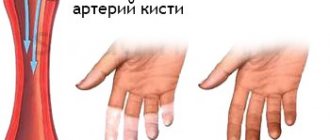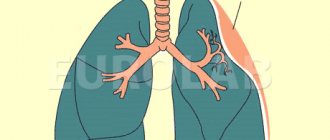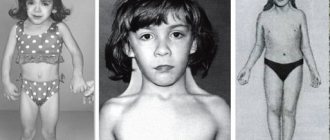Guillain-Barre syndrome
(GBS) is a rare neurological disorder in which the body's immune system mistakenly attacks part of its peripheral nervous system, a network of nerves located outside the brain and spinal cord.
GBS can range from very mild to almost complete paralysis, leaving the person unable to breathe on their own. Fortunately, most people eventually recover from even the most severe cases of GBS. After recovery, some people continue to have some weakness.
Guillain-Barré syndrome can occur at any age (though it is more common in adults and older adults), and both sexes are equally at risk for GBS. Statistically, 1 in 100,000 people develop GBS every year.
Causes of the disease
Scientists from different countries have been studying the syndrome for 100 years, but they still cannot fully figure out the exact reasons that provoke the occurrence of the disease.
It is believed that the appearance and development of the anomaly occurs due to a disruption of the patient’s immune system. When a person is completely healthy, when foreign cells enter the body, the immune system begins to fight the infection, rejecting all its dangerous elements. The patient is recovering. With GBS, the body begins to confuse “friends and foes”: the patient’s neurons are perceived as foreign and are subject to “attack.” When the nervous system is destroyed, a syndrome occurs.
What causes disturbances in the functioning of the immune system itself is not completely known. Experts include the most common reasons:
- Traumatic brain injuries. A strong blow to the head, any damage to it, as well as swelling, tumors or hemorrhages in the brain can be the main factor in the development of the syndrome. That is why, when a patient consults a specialist, first of all, the doctor must find out about the presence of any traumatic brain injuries.
- Infections. Recent viral infections greatly weaken a person's immune system, thereby increasing the likelihood of developing GBS. The body's defense mechanism perceives neurons as an infection and, with the help of white blood cells, continues to kill them. In this case, the syndrome appears one to three weeks after the infectious disease.
- Allergies. The disease often develops in allergy sufferers, for example, after chemotherapy, vaccination against polio and diphtheria, or severe surgical interventions.
- Genetic predisposition. Most diseases are inherited, and Guillain-Barre syndrome is no exception. If someone in the family has already suffered from a pathology, then most likely it will occur in their descendants. In this case, you need to especially monitor your health: take care of your head and try not to develop infectious diseases.
In childhood, the syndrome develops extremely rarely. The disease may be congenital or acquired. Any anomalies of intrauterine development can lead to the development of the syndrome:
- Preeclampsia;
- Frequent use of medications during pregnancy;
- The presence of autoimmune diseases in the mother;
- Long-term infections during pregnancy;
- Using drugs, drinking alcohol or smoking.
Acquired reasons include:
- Passive smoking of a child;
- Hormonal imbalances in the body;
- Vaccinations;
- Self-medication;
- Metabolic disease;
- Neurological disorders;
- Development of tumor processes.
Etiology
In most cases, the reasons for the expression of Guillain-Barré syndrome are unclear, since it is an autoimmune process. But experts identify several predisposing factors:
- complex course of infectious diseases;
- damage to the upper respiratory tract;
- infectious mononucleosis;
- complications from surgery or vaccination;
- HIV infection;
- craniocerebral diseases or injuries resulting in swelling or neoplasms in the brain. That is why there is a high probability of the syndrome influencing the human nervous system;
- genetic predisposition. If one of your close relatives has been diagnosed with this disease, then the person automatically falls into the risk zone. For this reason, the disease can manifest itself in a newborn child and school-age children;
- infections belonging to the group of herpes viruses.
Experts agree that Guillain-Barré syndrome is expressed during or after the course of the above diseases.
Symptoms
The disease can manifest itself in 3 forms:
- Spicy. All signs of the disease appear simultaneously within 1-2 days.
- Sub-acute. The incubation period is 15 to 20 days.
- Sluggish, chronic. This is one of the most dangerous forms, as it is practically untreatable.
The first symptoms of GBS in both children and adults resemble infection with a common viral respiratory infection:
- Aches in bones, joints;
- Hyperthermia;
- Severe weakness;
- Inflammation of the upper respiratory tract;
- Numbness of the limbs;
- Sometimes patients are bothered by various gastrointestinal disorders.
In addition to the general signs, there are also more obvious ones:
- Weakness of the limbs. Due to the destruction of nerve cells, there is a decrease or complete loss of sensitivity in the muscle area. At first, pain appears only in the lower legs, then discomfort affects the hands and feet. The patient is bothered by tingling and numbness in the fingers. In severe cases, coordination of movements is impaired: it becomes difficult for a person to independently hold a pen or write with the affected limb. It is worth noting that the symptoms of the disease appear symmetrically: 2 arms or legs are simultaneously affected.
- Enlargement of the abdomen, which is noticeable even visually. A protruding abdomen is one of the main indicators of the presence of the disease. This occurs due to the fact that the patient’s breathing changes to the abdominal type due to a weakening of the diaphragm.
- Incontinence. In a person with GBS, the healthy functioning of the bladder is impaired and urine begins to leak involuntarily.
- Difficulty swallowing. The swallowing reflex is impaired due to weakened pharyngeal muscles. In this case, the patient may even choke on saliva. The muscles of the mouth gradually weaken, which leads to discomfort while chewing food.
Guillain-Barré syndrome affects almost all organ systems, so unreasonable hypertension, tachycardia or banal visual impairment may be the first, albeit hidden, sign of the development of pathology.
Classification
There are several forms of Guillain-Barré syndrome depending on the symptoms and area of damage:
- classic (80% of cases) – inflammatory demyelinating polyradiculoneuropathy;
- axonal (15%) – motor or motor-sensory neuropathy, which is accompanied by damage to the axons of nerve fibers responsible for muscle movement and sensitivity;
- Miller-Fisher syndrome (3%) – a combination of ophthalmoplegia, areflexia with mild paresis and cerebellar ataxia;
- atypical (rare) – sensory neuropathy, pandysautonomia and cranial polyneuropathy.
Depending on the duration of the period of increase in signs of the disease:
- acute – 7-14 days;
- subacute – 15-28 days;
- chronic – observed over a long period of time (up to several months), characterized by a slow development of symptoms and alternating periods of remission and deterioration.
Chronic Guillain-Barré disease is considered one of the most dangerous because it is difficult to diagnose, which significantly reduces the chances of starting timely treatment.
How dangerous is the course of the syndrome?
Usually the anomaly develops slowly over 2-3 weeks. First, there is a slight weakness in the joints, which intensifies over time and really begins to cause discomfort to the patient.
Immediately after tingling, in the acute course of the disease, general malaise and weakness in the shoulder and hip regions occur. After a few hours, breathing difficulties appear. In this case, it is imperative to seek help from a hospital. Typically, the patient is immediately connected to an artificial respiration system, and then given the necessary medication and physiotherapeutic treatment.
In the acute form of the disease, the pathology can completely paralyze any limb on the second or third day.
Also, in the absence of timely treatment, the patient faces:
- Decreased immunity;
- Respiratory failure;
- Inactivity of joints;
- Peripheral paralysis;
- Problems of adaptation in society;
- Difficulty in living;
- Disability;
- Death.
Drug therapy
- Plasmapheresis with intravenous immunoglobulin is most often used. Plasma is partially separated from the patient's blood and formed elements are returned.
- Glucocorticoid drugs are also used for treatment - prednisolone (2 mc/kg per day), diphenhydramine and suprastin are administered as antihistamines.
- In the presence of tachycardia and severe arterial hypertension, it is usually treated with calcium ion antagonists and beta-blockers.
- Arterial hypertension is eliminated by injecting fluid into a vein to increase the volume in the vessels.
- To prevent bedsores, the patient must be turned over every 2-3 hours.
- Jumps in pressure and pulse can be explained by acute urinary retention and expansion of the bladder. In such cases, a catheter is installed.
- For speedy rehabilitation and prevention of contractures, exercise therapy, massage procedures, and four-chamber baths are often prescribed.
Diagnosis of the disease
In order to diagnose a patient with GBS, several aspects need to be clarified:
- When was the last time a person had any viral disease? It has been proven that in 80% of cases the syndrome occurs due to recent infections.
- Is the patient currently taking medications and, if so, what medications. They will also help cause the development of GBS.
- How long ago the patient was vaccinated against any diseases.
- Does the patient suffer from autoimmune or tumor diseases?
- Has the person undergone surgery recently?
- Whether there were serious injuries to any part of the body.
The following studies should also be carried out:
- General blood and urine analysis;
- Blood chemistry;
- Serological and virological examinations;
- Cerebrospinal fluid examination;
- Magnetic resonance imaging;
- Electrocardiography;
- Registration of electrical activity of muscles;
- X-ray or ultrasound of the affected area;
- External respiration examination;
- Study of basic vital signs.
Muscle weakness in several limbs simultaneously and tendon areflexia can be another clear sign of Guillain-Barré syndrome. This also includes various disorders in the pelvic area, polymorphonuclear leukocytes, asymmetries of paresis and sensitivity disorders.
Differential diagnosis
Despite the fact that the symptoms of GBS are similar to those of many other diseases (diphtheria, porphyria, transverse myelitis, botulism and myasthenia), they still need to be distinguished for further correct treatment. When making a differential diagnosis, the following factors should be taken into account:
- If polio is suspected, it is necessary to collect data from an epidemiological study, take into account symptoms of the gastrointestinal tract, identify high cytosis in the cerebrospinal fluid, asymmetry of the lesion and the absence of sensory impairment. The diagnosis can be confirmed using serological or virological analysis.
- Polyneuropathy is characterized by the appearance of psychopathological signs, as well as pain in the pelvic and abdominal areas. Deviation of the main indicators from the norm in the urine also indicates the development of the disease.
- Transverse myelitis accompanies dysfunction of the pelvic organs and the absence of damage to the nerves of the skull.
- Symptoms of the anomaly can be confused with cerebral infarction. But in this case, the pathology affects the body in a few minutes and often leads to coma. MRI will help determine the exact cause of the dysfunction of body systems.
- Botulism is characterized by the absence of sensitivity disorders and any changes in the cerebrospinal fluid.
What it is?
Guillain-Barré syndrome is an acute form of progressive inflammatory polyneuropathy, which is characterized by muscle weakness and polyneuritic sensitivity disorder. The disease is also called acute idiopathic polyneuritis, Landry's palsy, or inflammatory demyelinating polyradiculoneuropathy. The disease is a representative of autoimmune abnormalities.
Typically, pathology has specific signs that make it possible to recognize it at the earliest stages of development and begin adequate treatment in time. It has been proven that more than 80% of patients have a favorable prognosis and are completely cured.
Treatment
Patients diagnosed with GBS must be hospitalized in a hospital. In approximately 30% of cases, mechanical ventilation is necessary. Pathology therapy is performed at the following levels:
- Reanimation;
- Symptomatic;
- Blood purifying;
- Drug;
- Muscular-restorative;
- Preventative.
Resuscitation therapy
If the anomaly is in acute form, resuscitation treatment is carried out, which is aimed at relieving symptoms:
- The patient is connected to an artificial respiration system;
- A catheter is used to remove urine;
- A tracheal tube and probe are installed if there are problems with swallowing.
Symptomatic therapy
This type of treatment is carried out using various medications:
- Antihypertensive drugs: “Anaprilin”, “Metaprolol”;
- Antibiotic therapy: “Norfloxacin”;
- Drugs that help stabilize cardiac activity, “Anaprilin” (for tachycardia), “Piracetam” (for bradycardia);
- Low molecular weight heparin: “Hemapaxan”, “Certoparin”;
- Pain-relieving drugs – NSAIDs or Gabapentin, Pregabalin;
- Antipyretics, when the temperature rises above 38 degrees: “Ibuklin”, “Next”;
- Laxatives: Bisacodyl, Laxatin.
Plasmapheresis
One of the most effective procedures aimed at treating GBS is hardware blood purification - plasmapheresis. It helps stop the autoimmune process in the body. Indicated for severe and moderate disease. Usually about 4-6 operations are performed with a break of one day. Instead of plasma, a special isotonic solution of sodium or albumin is injected into the blood, through which the blood is cleansed and the functioning of all body systems is normalized.
Surgical treatment of the syndrome
If mechanical ventilation has been carried out for more than 7-10 days, a tracheostomy - an artificial windpipe - should be applied. In severe cases, a gastrostroma may be required - an opening in the stomach, surgically created for feeding the patient.
Non-drug therapy with folk remedies
It is impossible to cure GBS with folk remedies. But it is quite possible to cope with some of its symptoms:
- Fever. It is recommended to drink plenty of fluids and ventilate the room. Tea with lemon, infusions with different berries and dried fruits: cranberries, strawberries, currants, blueberries, raspberries and dried apricots will help lower the temperature. You can brew linden blossom, chamomile, St. John's wort, aspen buds, mint and thyme - leave for half an hour, then drink in small sips.
- Aching bones. Lingonberry tea, a compress of fresh cabbage leaves, horseradish and burdock, baths with pine extract or decoctions of medicinal herbs will help to cope with it.
- Weakness. Doctors recommend breathing fresh air and ventilating the room as often as possible. You should try to eat more proteins. You also need food rich in vitamins and microelements. And sweet strong tea or chocolate will help lift your spirits.
Rehabilitation
Due to the fact that the syndrome affects not only neurons, but also the periosteal muscles, the patient will have to learn to walk again and perform simple movements of the limbs.
To normalize healthy muscle function, you can use traditional treatment, which includes:
- Electrophoresis;
- Trituration;
- Radon baths;
- Massage;
- Baths to relax the body and muscle tone;
- Masks and compresses with paraffin or beeswax;
- Health-improving gymnastics.
During the recovery of the body, you should definitely go on a special therapeutic diet and at the same time take a course of vitamin preparations. Complexes containing calcium, potassium, magnesium and vitamin B will be especially useful.
Patients with GBS should register with a neurologist and undergo regular preventive examinations. It is worth remembering that timely, high-quality therapy can return the patient to a full life.
Prevention
There is no specific prevention of the disease. Doctors can only recommend treating all infectious diseases at the very beginning of their development, this will reduce the negative impact of pathogens on the nervous system.
Patients with previous Guillain-Barré syndrome should refrain from any vaccination for at least six months. Relapse of the disease can occur after any other infectious disease, so it is necessary to avoid possible sites of infection.
Forecast for the future
The mortality rate for GBS is quite low - only up to 5%. It is caused by the most severe manifestations of the syndrome - weakened breathing, immobilization and associated complications - pneumonia, pulmonary embolism and sepsis. The older the patient, the higher the chance of death.
Most people - about 85% - will make a full recovery and return to a full life. Moreover, only some of them will experience the disease again; the rest will leave it in the past forever.
Forecast for life
Most often, with Guillain-Barré syndrome, the prognosis is favorable. Typically, normal limb function is restored after 7-12 months in 85% of people. The disease becomes chronic in 7-15% of cases. The fatality rate is approximately 5%. The cause of death may be respiratory failure, pneumonia or viral infections. But most often, all this can be prevented by contacting a specialist in time.
Myositis Myasthenia gravis Neuritis of the facial nerve Parkinson's disease Lyme disease (tick-borne borreliosis): symptoms, treatment, photo Tetanus in humans










